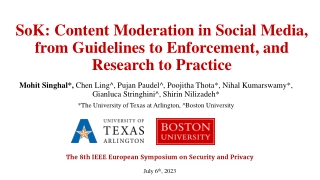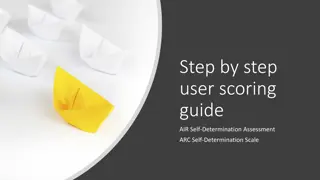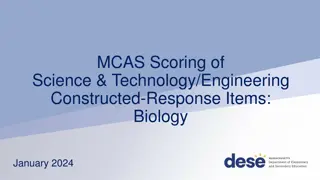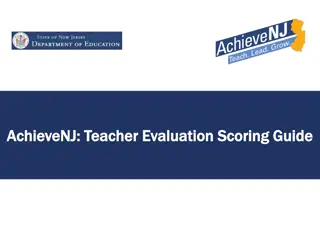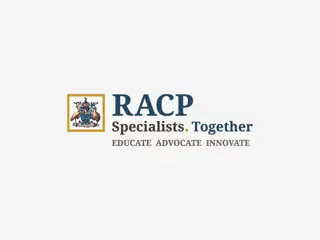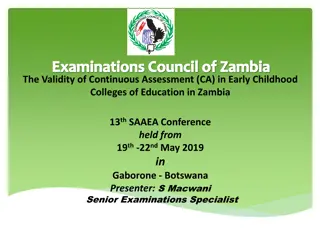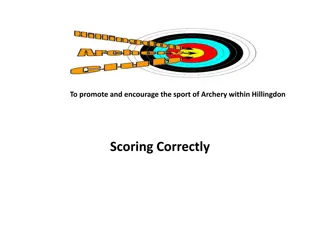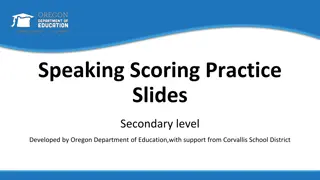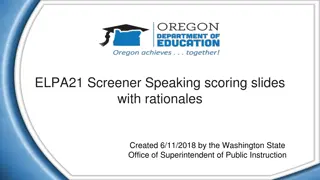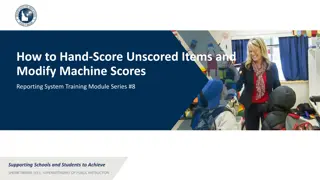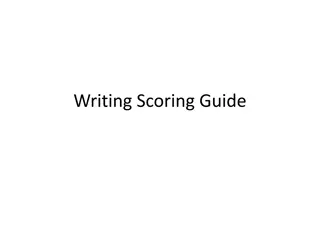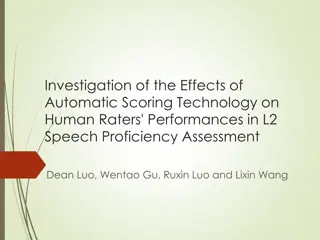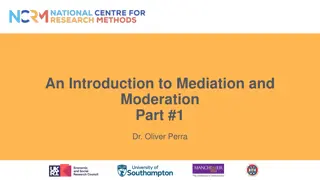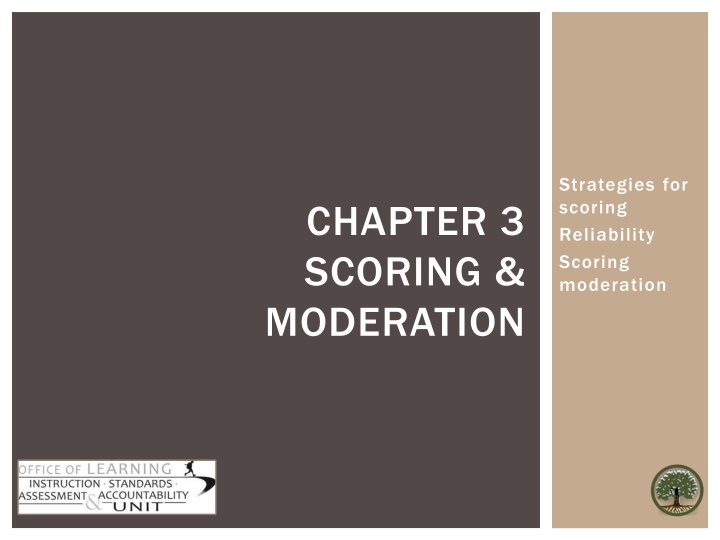
Scoring Reliability Strategies and Moderation in Assessment
Explore scoring strategies such as measuring complexity, types of items, reliable scoring methods, and ensuring consistency in scoring for assessments. Enhance assessment quality through reliable and valid scoring practices.
Download Presentation

Please find below an Image/Link to download the presentation.
The content on the website is provided AS IS for your information and personal use only. It may not be sold, licensed, or shared on other websites without obtaining consent from the author. If you encounter any issues during the download, it is possible that the publisher has removed the file from their server.
You are allowed to download the files provided on this website for personal or commercial use, subject to the condition that they are used lawfully. All files are the property of their respective owners.
The content on the website is provided AS IS for your information and personal use only. It may not be sold, licensed, or shared on other websites without obtaining consent from the author.
E N D
Presentation Transcript
Strategies for scoring Reliability Scoring moderation CHAPTER 3 SCORING & MODERATION
STRATEGIES FOR SCORING* The question format, options for how the student answers the question, and the way answers are scored should all measure the full range of complexity and depth of knowledge required in the learning target. Together, the question format, the options for how the student answers the question, and the way answers are scored provide a reasonable estimation of student mastery of the learning target. The connections between questions and their scoring criteria should be apparent to anyone familiar with the learning target. The rigor of scoring should increase in proportion to the stakes attached to the assessment and complexity of the item * As modified from Oregon Assessment Guideline (2014, p. 7)
SCORING FOR DIFFERENT ITEM TYPES Scoring is an activity to assign a value that can represent the degree of correct response to an assessment task Multiple-choice or Ordered Multiple-choice items Easy scoring; objective Short constructed response More time consuming to score, should have clear and objective scoring rubrics Extended constructed response Less objective, should have clear and objective scoring rubrics, more time consuming to score
RELIABLE SCORING The degree to which two or more scorers assign the same score to a single student response One type of reliability Component of Assessment Quality To be discussed in Chapter 6 Assessed by the use of two or more raters Use of scoring rubrics Can improve reliability since scores will be given consistently to a particular item Improve validity as a score is specifically given to one or a set of intended learning outcomes
ENSURING RELIABLE SCORING Selection of a set of responses Random samples of student work or Deliberately select from the high-, medium- and low-achieving groups of students Score by multiple people Check for exact matches, difference of one score, difference of two or more Discuss the results Evaluation of the effectiveness of scoring rubrics Training for additional scoring Evaluation of inter-rater reliability
OTHER ISSUES IN SCORING PROCESS Exemplar responses Responses that provide an excellent example of a particular scoring level Can be used to assist in the scoring process Borderline responses Even the best rubrics will result in some borderline responses Assign a score, perhaps with a +/- What to do with missing responses Not-reached response Skipped response Can code as 0, or simply leave out (e.g. not use in percentage calculations)
RIGOR OF SCORING Four main options for scoring constructed response items, in order of ascending rigor: 1. Teachers directly score their own students work 2. Blind-scoring Teachers score randomized and anonymous selection of their own student work 3. Multi-rater A selection of student work is scored by two different raters 4. Single or double scoring by third party Scoring is done by a separate, objective third party Most often related to high-stakes or standardized testing
SCORING MODERATION Activities: Ask two or more teachers to score the same portion of student work (for example, 25% of the total number of student work) A leader conducts a discussion of mismatched scores Discuss reasons for mismatched score to evaluate own scoring process Come to consensus Aims: To increase reliability Provide feedback for improving scoring rubrics For example, student responses in a single level may nevertheless look qualitatively different perhaps needing more than one level To promote professional development
BIBLIOGRAPHY Ebel, R. L., & Frisbie, D. A. (1991). Essentials of educational measurement. Englewood Cliffs, NJ: Prentice-Hall. Nitko, A. J., & Brookhart, S. (2007). Educational assessment of students. Upper Saddle River, NJ: Pearson Education, Inc. McMillan, J. H. (2007). Classroom assessment. Principles and practice for effective standard-based instruction (4th ed.). Boston: Pearson - Allyn & Bacon. Oregon Department of Education. (2014, June). Assessment guidance. Popham, W. J. (2014). Criterion-referenced measurement: A half-century wasted? Paper presented at the Annual Meeting of National Council on Measurement in Education, Philadephia, PA. Popham, W. J. (2014). Classroom assessment: What teachers needs to know. San Francisco, CA: Pearson Russell, M. K., & Airasian, P. W. (2012). Classroom assessment: Concepts and applications. New York, NY: McGraw-Hill. Stevens, D. & Levi, A. (2005). Introduction to rubrics. As assessment tool to save grading time, convey effective feedback, and promote student learning. Sterling: Stylus Publishing, LLC Wihardini, D. (2010). Assessment development II. Unpublished manuscript. Research and Development Department, Binus Business School, Jakarta, Indonesia. Wilson, M. (2005). Constructing measures: An item response modeling approach. New York: Psychology Press, Taylor & Francis Group. Wilson, M., & Sloane, K. (2000). From principles to practice: An embedded assessment system. Applied Measurement in Education, 13 (2), pp. 181-208.
CREATIVE COMMONS LICENSE Scoring and Moderation PPT by the Oregon Department of Education and Berkeley Evaluation and Assessment Research Center is licensed under a CC BY 4.0. You You are free to: are free to: Share Share copy and redistribute the material in any medium or format Adapt Adapt remix, transform, and build upon the material Under Under the following terms: the following terms: Attribution Attribution You must give appropriate credit, provide a link to the license, and indicate if changes were made. You may do so in any reasonable manner, but not in any way that suggests the licensor endorses you or your use. NonCommercial NonCommercial You may not use the material for commercial purposes. ShareAlike ShareAlike If you remix, transform, or build upon the material, you must distribute your contributions under the same license as the original. Oregon Department of Education welcomes editing of these resources and would greatly appreciate being able to learn from the changes made. To share an edited version of this resource, please contact Cristen McLean, cristen.mclean@state.or.us.

